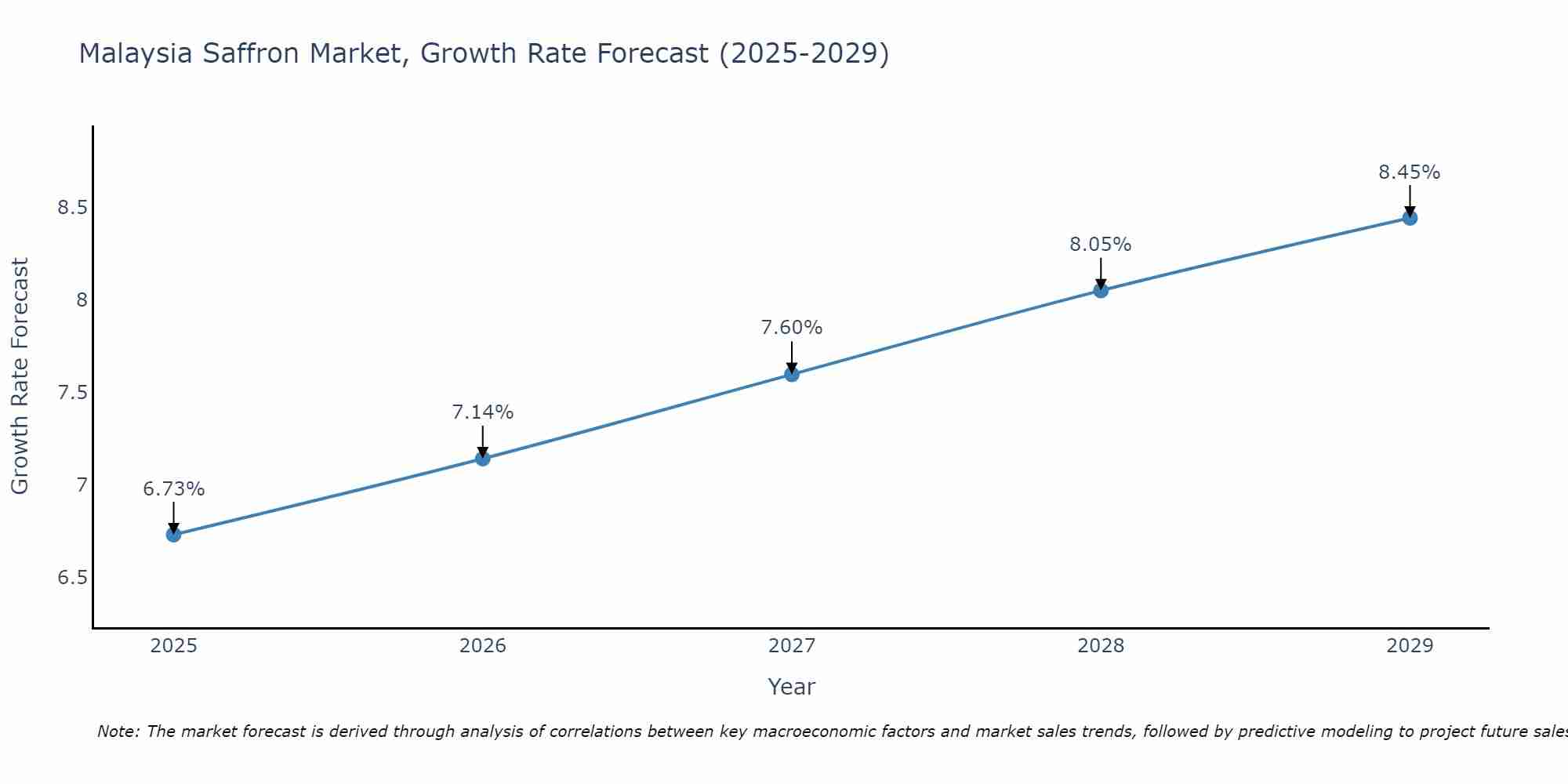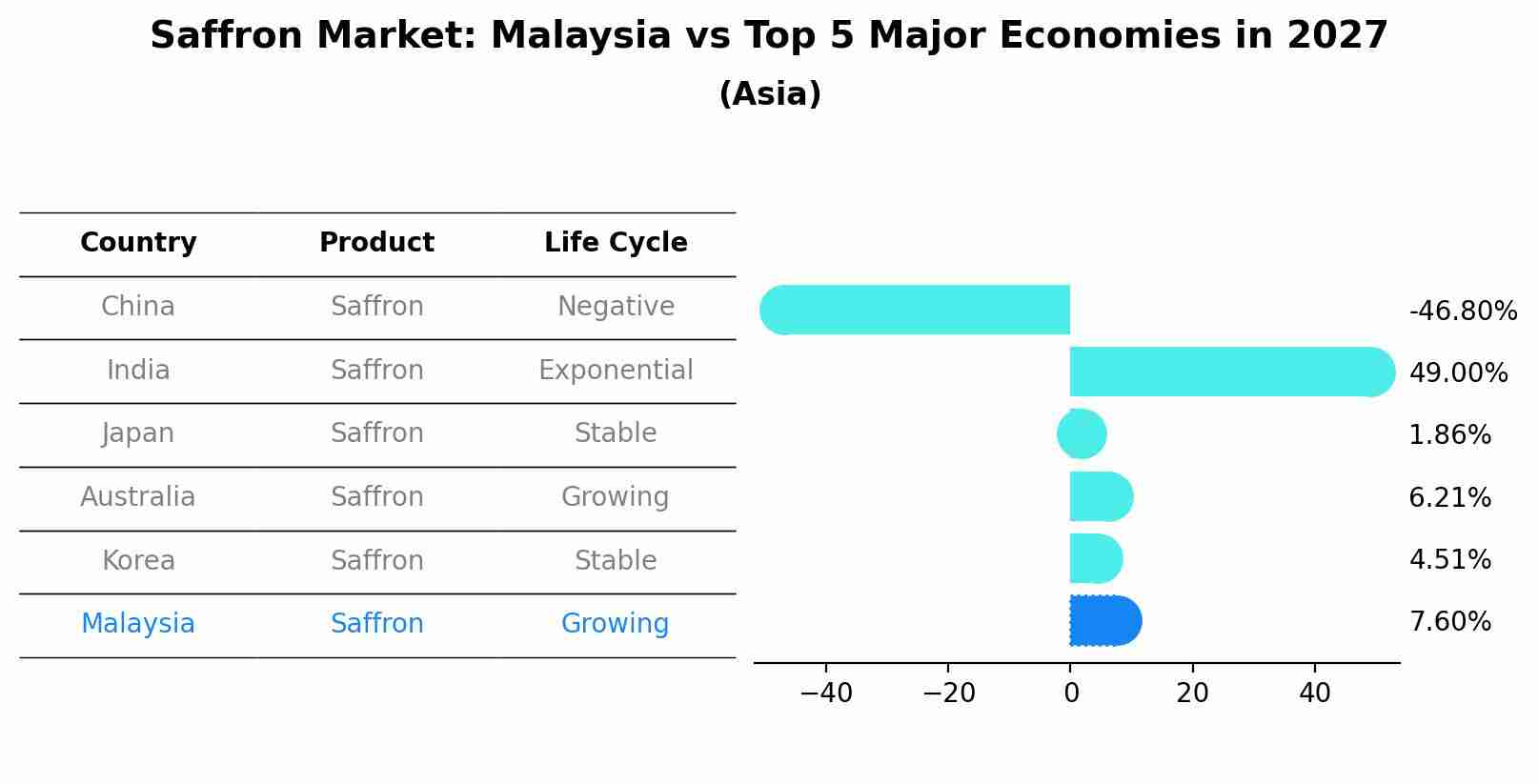Malaysia Saffron Market (2025-2031) Outlook | Forecast, Trends, Growth, Industry, Share, Size, Analysis, Revenue, Companies & Value
| Product Code: ETC279386 | Publication Date: Aug 2022 | Updated Date: Aug 2025 | Product Type: Market Research Report | |
| Publisher: 6Wresearch | Author: Ravi Bhandari | No. of Pages: 75 | No. of Figures: 35 | No. of Tables: 20 |
Malaysia Saffron Market Size Growth Rate
The Malaysia Saffron Market is poised for steady growth rate improvements from 2025 to 2029. From 6.73% in 2025, the growth rate steadily ascends to 8.45% in 2029.

Saffron Market: Malaysia vs Top 5 Major Economies in 2027 (Asia)
By 2027, the Saffron market in Malaysia is anticipated to reach a growth rate of 7.60%, as part of an increasingly competitive Asia region, where China remains at the forefront, supported by India, Japan, Australia and South Korea, driving innovations and market adoption across sectors.

Malaysia Saffron Market Synopsis
The Malaysia Saffron market is a specialized segment driven by the use of saffron in culinary and medicinal applications. Saffron`s unique flavor and medicinal properties have led to its increased use in traditional and contemporary cuisines. The market is influenced by the growing interest in gourmet cooking and natural remedies. While saffron is a high-value spice, its market size in Malaysia is relatively small, but it is expected to see modest growth as consumer preferences evolve.
Drivers of the Market
The saffron market in Malaysia is experiencing steady growth, driven by several factors. Firstly, saffron is increasingly recognized for its health benefits and culinary uses, leading to growing consumer demand. It is considered a premium spice in Malaysia cuisine, and its popularity is expected to rise further as people explore international cooking styles. Additionally, saffron is also used in traditional medicine practices, which contribute to its market growth. The market is also influenced by the increasing availability of saffron products through both traditional retail outlets and e-commerce platforms.
Challenges of the Market
The Malaysia saffron market faces several challenges, primarily related to the high cost and limited availability of genuine saffron. Counterfeiting and adulteration are persistent issues that can undermine consumer trust and damage the reputation of saffron products. Moreover, saffron cultivation is highly sensitive to climate conditions and requires specific expertise, making it susceptible to supply fluctuations. Economic factors and consumer preferences can also impact the demand for saffron, which is considered a luxury spice. Maintaining quality standards, combating counterfeiting, and ensuring a consistent supply chain are key challenges in this market.
COVID 19 Impact on the Market
The saffron market in Malaysia, while relatively niche, encountered disruptions due to the COVID-19 pandemic. International travel restrictions affected saffron imports, and consumers turned to local alternatives. However, as global travel and trade resume, there is potential for growth in this market. Malaysia saffron producers should focus on quality, organic cultivation methods, and innovative product offerings to tap into the expanding culinary and wellness sectors.
Key Players in the Market
The saffron market in Malaysia is niche but growing, driven by the rising interest in gourmet cuisine and traditional medicine. Key players such as Sahar Saffron and Persia Darbar are known for their premium saffron products, catering to the discerning tastes of consumers.
Key Highlights of the Report:
- Malaysia Saffron Market Outlook
- Market Size of Malaysia Saffron Market, 2024
- Forecast of Malaysia Saffron Market, 2031
- Historical Data and Forecast of Malaysia Saffron Revenues & Volume for the Period 2021-2031
- Malaysia Saffron Market Trend Evolution
- Malaysia Saffron Market Drivers and Challenges
- Malaysia Saffron Price Trends
- Malaysia Saffron Porter's Five Forces
- Malaysia Saffron Industry Life Cycle
- Historical Data and Forecast of Malaysia Saffron Market Revenues & Volume By Grade for the Period 2021-2031
- Historical Data and Forecast of Malaysia Saffron Market Revenues & Volume By Grade I for the Period 2021-2031
- Historical Data and Forecast of Malaysia Saffron Market Revenues & Volume By Grade II for the Period 2021-2031
- Historical Data and Forecast of Malaysia Saffron Market Revenues & Volume By Grade III for the Period 2021-2031
- Historical Data and Forecast of Malaysia Saffron Market Revenues & Volume By Grade IV for the Period 2021-2031
- Historical Data and Forecast of Malaysia Saffron Market Revenues & Volume By Application for the Period 2021-2031
- Historical Data and Forecast of Malaysia Saffron Market Revenues & Volume By Food for the Period 2021-2031
- Historical Data and Forecast of Malaysia Saffron Market Revenues & Volume By Medical for the Period 2021-2031
- Historical Data and Forecast of Malaysia Saffron Market Revenues & Volume By Cosmetics for the Period 2021-2031
- Historical Data and Forecast of Malaysia Saffron Market Revenues & Volume By Others for the Period 2021-2031
- Malaysia Saffron Import Export Trade Statistics
- Market Opportunity Assessment By Grade
- Market Opportunity Assessment By Application
- Malaysia Saffron Top Companies Market Share
- Malaysia Saffron Competitive Benchmarking By Technical and Operational Parameters
- Malaysia Saffron Company Profiles
- Malaysia Saffron Key Strategic Recommendations
Frequently Asked Questions About the Market Study (FAQs):
1 Executive Summary |
2 Introduction |
2.1 Key Highlights of the Report |
2.2 Report Description |
2.3 Market Scope & Segmentation |
2.4 Research Methodology |
2.5 Assumptions |
3 Malaysia Saffron Market Overview |
3.1 Malaysia Country Macro Economic Indicators |
3.2 Malaysia Saffron Market Revenues & Volume, 2021 & 2031F |
3.3 Malaysia Saffron Market - Industry Life Cycle |
3.4 Malaysia Saffron Market - Porter's Five Forces |
3.5 Malaysia Saffron Market Revenues & Volume Share, By Grade, 2021 & 2031F |
3.6 Malaysia Saffron Market Revenues & Volume Share, By Application, 2021 & 2031F |
4 Malaysia Saffron Market Dynamics |
4.1 Impact Analysis |
4.2 Market Drivers |
4.2.1 Growing awareness about the health benefits of saffron |
4.2.2 Increasing demand for natural food ingredients and flavors |
4.2.3 Rising consumer preference for premium and exotic ingredients |
4.3 Market Restraints |
4.3.1 High cost of saffron compared to other spices |
4.3.2 Limited availability of saffron due to specific growing conditions |
4.3.3 Presence of counterfeit saffron in the market affecting consumer trust |
5 Malaysia Saffron Market Trends |
6 Malaysia Saffron Market, By Types |
6.1 Malaysia Saffron Market, By Grade |
6.1.1 Overview and Analysis |
6.1.2 Malaysia Saffron Market Revenues & Volume, By Grade, 2021-2031F |
6.1.3 Malaysia Saffron Market Revenues & Volume, By Grade I, 2021-2031F |
6.1.4 Malaysia Saffron Market Revenues & Volume, By Grade II, 2021-2031F |
6.1.5 Malaysia Saffron Market Revenues & Volume, By Grade III, 2021-2031F |
6.1.6 Malaysia Saffron Market Revenues & Volume, By Grade IV, 2021-2031F |
6.2 Malaysia Saffron Market, By Application |
6.2.1 Overview and Analysis |
6.2.2 Malaysia Saffron Market Revenues & Volume, By Food, 2021-2031F |
6.2.3 Malaysia Saffron Market Revenues & Volume, By Medical, 2021-2031F |
6.2.4 Malaysia Saffron Market Revenues & Volume, By Cosmetics, 2021-2031F |
6.2.5 Malaysia Saffron Market Revenues & Volume, By Others, 2021-2031F |
7 Malaysia Saffron Market Import-Export Trade Statistics |
7.1 Malaysia Saffron Market Export to Major Countries |
7.2 Malaysia Saffron Market Imports from Major Countries |
8 Malaysia Saffron Market Key Performance Indicators |
8.1 Consumer demand trends for saffron-based products |
8.2 Number of new product launches containing saffron |
8.3 Growth in saffron imports and exports |
8.4 Number of saffron farms or cultivation areas in Malaysia |
8.5 Adoption rate of saffron in various industries such as food, cosmetics, and pharmaceuticals |
9 Malaysia Saffron Market - Opportunity Assessment |
9.1 Malaysia Saffron Market Opportunity Assessment, By Grade, 2021 & 2031F |
9.2 Malaysia Saffron Market Opportunity Assessment, By Application, 2021 & 2031F |
10 Malaysia Saffron Market - Competitive Landscape |
10.1 Malaysia Saffron Market Revenue Share, By Companies, 2024 |
10.2 Malaysia Saffron Market Competitive Benchmarking, By Operating and Technical Parameters |
11 Company Profiles |
12 Recommendations |
13 Disclaimer |
- Single User License$ 1,995
- Department License$ 2,400
- Site License$ 3,120
- Global License$ 3,795
Search
Thought Leadership and Analyst Meet
Our Clients
Related Reports
- Canada Oil and Gas Market (2026-2032) | Share, Segmentation, Value, Industry, Trends, Forecast, Analysis, Size & Revenue, Growth, Competitive Landscape, Outlook, Companies
- Germany Breakfast Food Market (2026-2032) | Industry, Share, Growth, Size, Companies, Value, Analysis, Revenue, Trends, Forecast & Outlook
- Australia Briquette Market (2025-2031) | Growth, Size, Revenue, Forecast, Analysis, Trends, Value, Share, Industry & Companies
- Vietnam System Integrator Market (2025-2031) | Size, Companies, Analysis, Industry, Value, Forecast, Growth, Trends, Revenue & Share
- ASEAN and Thailand Brain Health Supplements Market (2025-2031) | Strategy, Consumer Insights, Analysis, Investment Trends, Opportunities, Growth, Size, Share, Industry, Revenue, Segments, Value, Segmentation, Supply, Forecast, Restraints, Outlook, Competition, Drivers, Trends, Demand, Pricing Analysis, Competitive, Strategic Insights, Companies, Challenges
- ASEAN Bearings Market (2025-2031) | Strategy, Consumer Insights, Analysis, Investment Trends, Opportunities, Growth, Size, Share, Industry, Revenue, Segments, Value, Segmentation, Supply, Forecast, Restraints, Outlook, Competition, Drivers, Trends, Demand, Pricing Analysis, Competitive, Strategic Insights, Companies, Challenges
- Europe Flooring Market (2025-2031) | Outlook, Share, Industry, Trends, Forecast, Companies, Revenue, Size, Analysis, Growth & Value
- Saudi Arabia Manlift Market (2025-2031) | Outlook, Size, Growth, Trends, Companies, Industry, Revenue, Value, Share, Forecast & Analysis
- Uganda Excavator, Crane, and Wheel Loaders Market (2025-2031) | Strategy, Consumer Insights, Analysis, Investment Trends, Opportunities, Growth, Size, Share, Industry, Revenue, Segments, Value, Segmentation, Supply, Forecast, Restraints, Outlook, Competition, Drivers, Trends, Demand, Pricing Analysis, Competitive, Strategic Insights, Companies, Challenges
- Rwanda Excavator, Crane, and Wheel Loaders Market (2025-2031) | Strategy, Consumer Insights, Analysis, Investment Trends, Opportunities, Growth, Size, Share, Industry, Revenue, Segments, Value, Segmentation, Supply, Forecast, Restraints, Outlook, Competition, Drivers, Trends, Demand, Pricing Analysis, Competitive, Strategic Insights, Companies, Challenges
Industry Events and Analyst Meet
Whitepaper
- Middle East & Africa Commercial Security Market Click here to view more.
- Middle East & Africa Fire Safety Systems & Equipment Market Click here to view more.
- GCC Drone Market Click here to view more.
- Middle East Lighting Fixture Market Click here to view more.
- GCC Physical & Perimeter Security Market Click here to view more.
6WResearch In News
- Doha a strategic location for EV manufacturing hub: IPA Qatar
- Demand for luxury TVs surging in the GCC, says Samsung
- Empowering Growth: The Thriving Journey of Bangladesh’s Cable Industry
- Demand for luxury TVs surging in the GCC, says Samsung
- Video call with a traditional healer? Once unthinkable, it’s now common in South Africa
- Intelligent Buildings To Smooth GCC’s Path To Net Zero


















